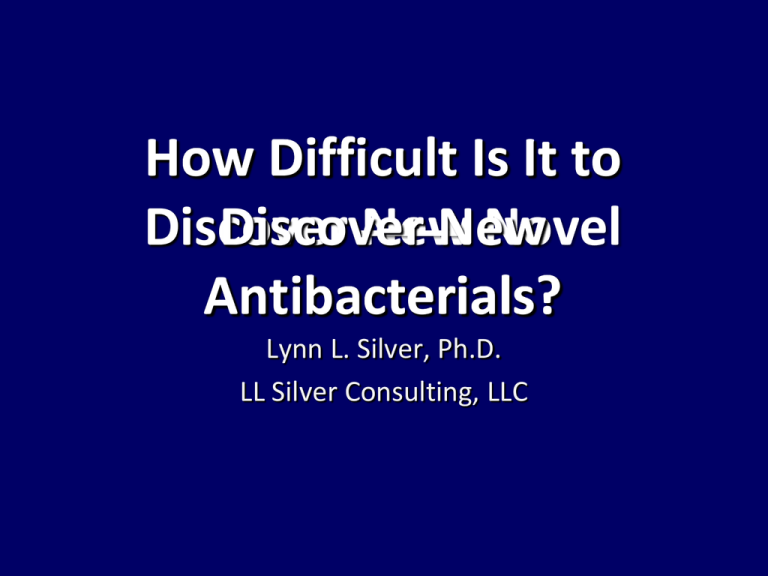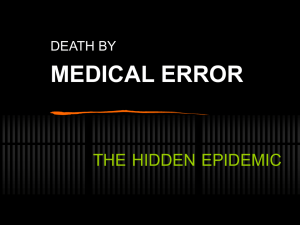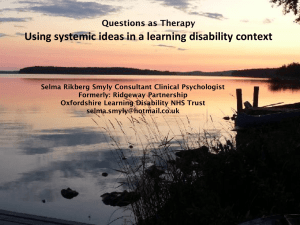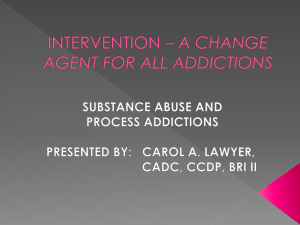ppt 293 KB
advertisement

How Difficult Is It to Discover Discover New New Novel Antibacterials? Lynn L. Silver, Ph.D. LL Silver Consulting, LLC 2 Antibacterials at FDA 2000-2011 Compound Usage Class Active versus resistance Discovery of class Linezolid Systemic IV/oral Oxazolidinones MRSA 1978 2000 Ertapenem Systemic IV/IM Carbapenem 1976 2001 Cefditoren Systemic oral Cephalosporin 1948 2001 Gemifloxacin Systemic oral Fluoroquinolone 1961 2003 Daptomycin Systemic oral Lipopeptide MRSA 1987 2003 Telithromycin Systemic oral Macrolide+ EryR S. pneumo 1952 2004 Tigecycline Systemic IV Tetracycline+ TetR 1948 2005 Faropenem Systemic oral Penem Retapamulin Topical Pleuromutilin Dalbavancin Systemic IV Glycopeptide 1953 Doripenem Systemic IV Carbapenem 1976 Oritavancin Systemic IV Glycopeptide+ VRE 1953 2008 Cethromycin Systemic oral Macrolide+ EryR S. pneumo 1952 2009 Iclaprim Systemic IV Trimethoprim+ TrmR 1961 2009 Besifloxacin Ophthalmic Fluoroquinolone Telavancin Systemic IV Glycopeptide+ Ceftobiprole Systemic IV Ceftaroline Fidaxomicin 1978 MRSA Fail at FDA Pass at FDA 2006 1952 2007 2007 2007 1961 2009 VRE 1953 2009 Cephalosporin+ MRSA 1948 Systemic IV Cephalosporin+ MRSA 1948 2010 Oral CDAD Lipiarmycin 1975 Due soon 2009 3 Discovery Timeline Last novel agent to reach the clinic was discovered in 1987 Fidaxomicin Retapamulin 2005 Linezolid Bactroban daptomycin monobactams 1995 1930 sulfonamide penicillin 2000 Daptomycin Synercid 1990 1985 Norfloxacin Imipenem 1980 lipiarmycin oxazolidinones cephamycin 1975 carbapenem fosfomycin 1970 mupirocin lincomycin fusidic acid 1965 metronidazole novobiocin nalidixic acid cycloserine 1960 trimethoprim isoniazid rifamycin 1955 erythromycin vancomycin cephalosporin streptogramins 1950 pleuromutilin bacitracin chlortetracycline chloramphenicol 1945 polymyxin streptomycin 1940 1935 2010 Although development and modification of old classes has proceeded – no newly discovered novel classes have made it to the clinic in 24 years 4 Discovery Strategies 2010 2005 2000 1995 1990 1985 1980 1975 1970 1965 1960 1955 1950 1945 1940 1935 Screening for and design of novel antibacterials was vigorously pursued by Big Pharma until recently 5 Consider… If Big Pharma (and biotechs) have been largely unsuccessful in finding novel antibacterials to develop… Will that be reversed by Increasing financial incentives? Revising regulatory policy? What has prevented novel discovery? The need to address scientific obstacles 6 Genomics Gene-to-Drug Approach Novel antibacterial targets High Throughput Screening Inhibit the enzyme Smallmolecule molecule ‘Hits’ Small ‘Hits’ Inhibit bacterial growth Inhibit bacterial growth by inhibiting the enzyme Druglike properties Low resistance potential Smallmolecule molecule ‘Leads’ Small ‘Leads’ ez ez ab ab Candidates Candidates Preclinical testing Clinical Trials Drug 7 The Obstacles to Antibacterial Discovery Improve chemical sources Remove toxic, detergent, reactive compounds from libraries Define physicochemical characteristics specifying bacterial entry & efflux Revive natural product screening Pursue targets with low resistance potential 8 -lactams Glycopeptides Cycloserine Fosfomycin The bacterial entry problem gram positive Cytoplasm Rifampin Aminoglycosides Tetracyclines Chloramphenicol Macrolides Lincosamides Oxazolidinones Fusidic Acid Mupirocin Novobiocin Fluoroquinolones Sulfas Trimethoprim Metronidazole Daptomycin Almost all “gram positive” Polymyxin drugs are active (biochemically) on the analogous gram negative targets – but the drugs are not antibacterial vs gram negatives P. Aeruginosa is more problematic due to strong efflux and reduced permeability Periplasm CM Gram negative P. aeruginosa Cytoplasm Impermeability and efflux of Grender many agents inactive CM OM 9 Antibacterials Useful in Targets Systemic with low Monotherapy resistance potential ANTIBACTERIAL -lactams Examine TARGET multiple penicillin binding proteins [PBPs] successful antibacterials synthesis of cell wall peptidoglycan Glycopeptides Tetracycline Aminoglycosides Macrolides Lincosamides Chloramphenicol Oxazolidinones Fluoroquinolones Metronidazole Daptomycin D-ala-D-ala of peptidoglycan substrate rRNA of 30s ribosome subunit rRNA of 30s ribosome subunit rRNA of 50s ribosome subunit rRNA of 50s ribosome subunit rRNA of 50s ribosome subunit rRNA of 50s ribosome subunit bacterial topoisomerases (gyrase and topo IV) DNA membranes enzymes All have multiple targets or targets encoded by multiple genes No high-level resistance by single-step mutation 10 Single Enzyme Targets of Antibiotics in Clinical Use ANTIBIOTIC TARGET USE rifampicin RNA polymerase Multi-drugTB therapy isoniazid InhA Multi-drug TB therapy streptomycin 30s ribosome/rpsL Multi-drug TB therapy trimethoprim DHFR (FolA) Combo w/ Sulfas sulfamethoxazole PABA synthase (FolP) Combo w/ Trimethoprim novobiocin DNA gyrase B subunit Multi-drug therapy mupirocin Ile tRNA-synthetase Topical therapy fosfomycin MurA UTI All are subject to single-step high level resistance 11 Based on existing antibacterial drugs… Successful monotherapeutic antibacterials Not subject to single-site mutation to high level resistance because they are multi-targeted Current drugs inhibiting single enzymes Generally used in combination because they are subject to single mutation to significant resistance THUS: "Multitargets" are preferable to single enzyme targets for systemic monotherapy BUT: The search for single enzyme inhibitors has been the mainstay of novel discovery for at least 20 years … 12 If single enzyme targets give rise to resistance in the laboratory… Determine if the in vitro (laboratory) resistance is likely to translate to resistance in the clinic Standardize the use of models for evolution of resistance under therapeutic conditions To validate targets, test target/lead pairs in these models Pursue multitargets 13 A way forward Targets Chemicals For single-enzyme inhibitors: Robust modeling of resistance Pursue multi-targets Deduce rules for bacterial entry and efflux, especially in GClean up libraries and incorporate rules for entry Revive Natural Products With better chemicals, return to empirical discovery Collaboration between academe and industry Computation for multitargeting Modeling of resistance Chemistry for cell entry and efflux avoidance 14 15 Antibacterials Are Chemically Unlike other Drugs gram negative gram positive only cLogD7.4 = GREASINESS other drugs MW = SIZE Mammalian targets ≠ antibacterial targets Many antibacterials must enter bacterial cells + 16 Cytoplasm-targeted antibacterials 8.0 Gram positive only Cytoplasmic 6.0 Gram negative cytoplasmic entry by diffusion cLogP = Greasiness 4.0 2.0 0.0 -2.0 Gram negative cytoplasmic carrier-mediated transport -4.0 -6.0 0 200 400 600 MW = SIZE 800 1000 1200 17 An approach to new multitargets: Sorting targets by their ligands Compound and fragment profiling binding/docking to bacterial proteins Can be done computationally Candidate multitargets 18 What is Antibacterial Multitargeting? Targeting the products of multiple genes – or the product of their function – such that single mutations cannot lead ciprofloxacin to high level resistance Two or more essential gene products with similar active sites: DNA Gyrase & Topisomerase IV Gyrase Topo IV Products of identical genes : rRNA gentamicin tetracycline Essential structures produced by a pathway where chloramphenicol linezolid structural changes cannot be made by single erythromycin mutations: Membranes Lipid II GlcNAc These and other known multiargets have beenMurNAc pursued PP-C More may be uncovered by computation based on structural vancomycin studies of bacterial proteins and the small molecule “ligands” daptomycin that bind to them 55









